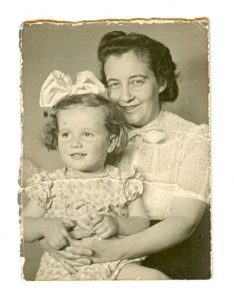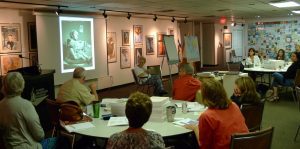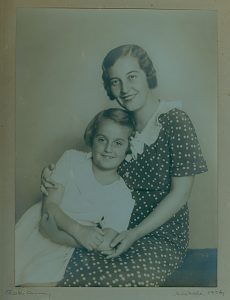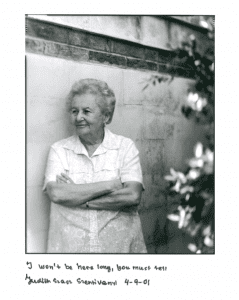Story #7 Judith Szentivanyi
Conditions began to change in 1939. Many Hungarians sympathized with the Nazi party and approved of Hitler’s actions against the Jewish population. “People who had been friendly with us before turned away their heads when we met on the street,” Judith recalls. During this time, Jewish men were forced into labor camps, and Jewish members of the Hungarian Army “were stripped of their ranks.” Many men were sent to work in dangerous minefields, and most did not return, including two of Judith’s uncles.
Judith’s father, however, was taken to a labor camp in the Ukraine, where he worked as a dentist. Without her father, Judith and her mother and younger sister, born ten years after Judith, were left with no income and were forced to sell their belongings after exhausting their financial reserves. Between 1939 and 1944, her father occasionally returned from the work camps only to be taken away again, increasing confusion and uncertainty.
Following the German invasion of Hungary in March 1944, life in Miskolc changed drastically. Jews were banned from public places such as parks and swimming pools and forced to sew yellow stars onto their clothing. Many were soon forced into ghettos. At first, families of physicians were allowed to remain in their homes, which “gave us some optimism, because we believed that physicians were needed and we would be spared,” Judith recalls. Later, in the spring of 1944, Judith and the rest of her family were taken to a brick factory in Miskolc along with the population of the ghetto. “The good people of the city were standing on the sidewalks of the streets and were spitting on us,” Judith says. While they were held captive in the factory, a list of names was read out, and those on the list were questioned about hidden valuables and severely beaten. Judith was relieved not to hear her mother’s name called.
After being held at the factory, Judith was packed into a crowded boxcar with her mother and sister. “The Germans by that time had practically lost the war,” Judith says, “but their main concern was still how to kill Jews.” Of the 96 people transported in that boxcar, Judith is one of five Survivors.
After four or five days, Judith arrived at Auschwitz-Birkenau. “There were German soldiers standing around, and they selected people, some right, some left,” Judith recalls. “The decision was the following: all the mothers with children were sent to one side, also all the old people, and all those people who looked not completely healthy. The rest, including me, were sent to the other side.” Judith was separated from her mother and six-year-old sister during the selection.
“I wanted so much to go with them but they did not let me,” Judith recalls. “Somebody told me that they went to ‘H Lager.’ Later I asked a German guard where the ‘H Lager’ was, and he told me that is the Heaven Lager.”
 (Judith’s mother Magda and her sister Emilia)
(Judith’s mother Magda and her sister Emilia)
Judith was held Auschwitz-Birkenau for several days. The prisoners’ heads were shaved and women were given a single striped dress to wear. Judith was soon loaded again onto a boxcar and taken to the Płaszów labor camp, near Krakow, where she was held for roughly five months. Prisoners were given pointless work designed to keep them busy and suffering. Judith recalls running from one side of the camp to the other carrying heavy stones, only to later run the stones back in the opposite direction. Other work included hammering nails, an equally pointless exercise. “If we didn’t do it fast enough we were beaten,” Judith says. At Płaszów, women slept five to a bunk and worked all day, beginning in the early morning.
By the end of 1944, rumors of the approaching Russian army reached Krakow, and the Germans began to liquidate Płaszów. Judith was taken back to Auschwitz, where she survived another selection and remained throughout the winter. “We did not work there,” Judith recalls, “we just were standing around, and they looked at us and they decided who looks good, who does not look good, and those people who did not look well enough, those people were also selected out.”
Judith was transported again, this time to Parschnitz in German-occupied Czechoslovakia, a subcamp of the Gross-Rosen concentration camp. From there, prisoners took a train every day to Trautenau, the German name for the Czech city of Trutnov. In Trutnov, prisoners worked in a factory run by AEG (Allgemeine Elektricitäts-Gesellschaft, or the German Electric Company), producing airplane parts. Judith recalls few of the specifics of her work at AEG, only that it was not as bad as Płaszów. Yet the women were still cold and poorly dressed, and had to run every day to catch the train that transported them between Parschnitz and Trutnov.
“That was very difficult,” Judith remembers, “because it was very cold, already it was winter. We did not have any clothing, and it was very, very cold, but we had to do it every day.” As the war neared its end and the German army ran low on food and supplies, prisoners were fed hardly anything.
Judith remained at Parschnitz until the end of the war, when the camp was liberated by the Russian army in May of 1945. Judith was first taken to a hospital in Trutnov then sent home to Hungary, where she was reunited with her father.
“I was faced with the probability that I would find none of my family alive,” Judith recalls of her return home. “I really was very, very happy that I found him alive, at home, because I did not expect him to be alive. I didn’t expect anybody to be alive, but he was, and that was a very great thing for me,” Judith says. Her father, she learned, survived the war by escaping from the labor camp and hiding with a family in Miskolc. “They could have been killed for their goodness,” Judith says of the family that hid her father.
Upon her return home, Judith learned that twenty-six members of her family had been killed in the Holocaust, including her mother and six-year-old sister. Judith was re-enrolled in school, and her father worked as the president of the Joint Distribution Committee of North Hungary. “He went every day to the railroad station,” Judith recalls, “waiting for those who arrived, and there were not too many. But, some, some arrived. Some survived.”
After completing high school Judith attended medical school, and in 1948 married Andor Szentivanyi, whom she had known since childhood. Together, they left Hungary in 1956, during the unsuccessful Hungarian Revolution against the Soviet Union, and soon came to America. “I had an uncle here, who was a half-brother of my mother, and he practically took us in as children,” Judith says. “Before the war I didn’t even know him.” Judith worked as a dermatologist and later moved to Florida with her husband and children.
 (Judith speaking to educators at The Florida Holocaust Museum in 2011)
(Judith speaking to educators at The Florida Holocaust Museum in 2011)
Since The Florida Holocaust Museum’s inception, Judith has told her story many times to a variety of audiences, often to students and teachers. For Judith, The FHM’s 25th Anniversary indicates the importance of memory and history. “The Holocaust Museum is a very important thing,” Judith says, “to keep in mind what really happened.” Although she can no longer drive to speak at the Museum, Judith is still quick to share her story. “We forgot what happened during the First World War,” Judith recalls, and cautions that there is a risk the world will similarly forget the Second World War. “Already many people don’t remember. […] This is not the whole story, of course, only part of the story, but, as time goes by, and I become older, it’s more important to remember everything.”
Story by: Sarah Hagerty, Jennifer Mohn, and Rachel Saltzgiver
Edited by: Jared Stark and Kristen Wright


